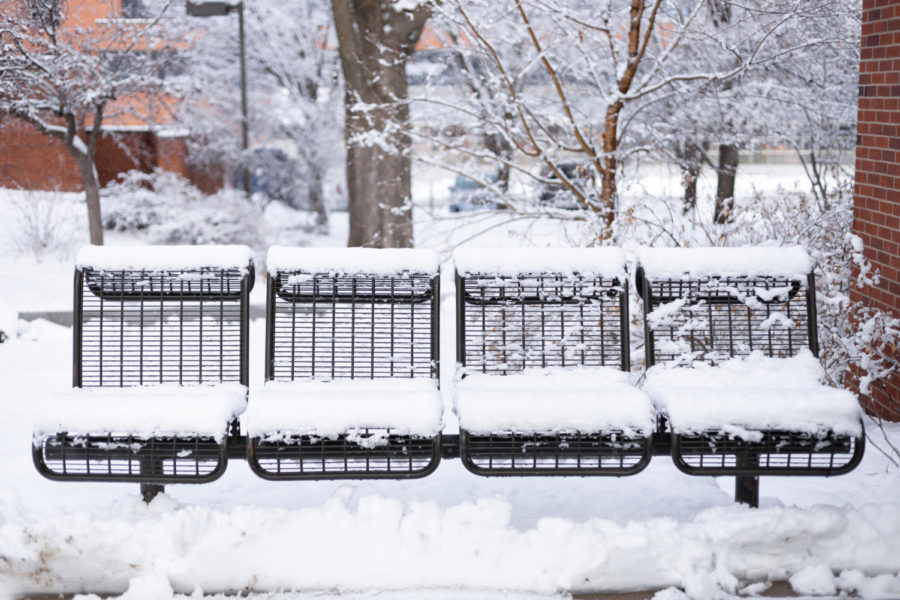Old equipment sold at Purchasing Warehouse
February 6, 2002
Faded red lounge chairs sit in two rows, one above the other, for $3 apiece.
Botany journals from the early 1980s sit above genetics journals from the late 1970s, all available for a quarter each.
Power Macintosh G3 computers from late 1997 are a few feet away from a stack of HP Vectras with 486DX2 chips.
Two Pioneer LaserDisc players, their 1980 and 1991 vintages evident in their design, are tagged at $40 each.
It’s Wednesday at the ISU Purchasing Warehouse, a nondescript metal building north of the genetics laboratory. It’s the place where university equipment goes to die – or find a new life. When Iowa State upgrades, the victims come here, for resale at fractions of their original price. Mark Ludwig, supervisor of the warehouse, tags items ranging from slide projectors – priced at $20 – to a spectrophotometer and auxiliary equipment – up for $50 “as one unit.”
The word to describe his job, he said while leaning against a Stairmaster, is “interesting.”
“It’s a challenge, something different, something new every day,” Ludwig said.
Ludwig, who has been on the job for three years, couldn’t single out the strangest thing he’d seen.
“You’ll see everything come through here,” he said. Last month, Ludwig said, he sold an electromagnet to a college in Kentucky.
A list of items and pictures of some of the more expensive items can be seen by clicking on “ISU Surplus” at the Central Stores Web site, www.iastate. edu/~centrals. Since November, the site has had more than 2,000 hits. Some items are also sold by auction at the site.
The warehouse’s goal is to try and get the best money back for the university, Ludwig said. The public sale on Wednesdays from noon to 3 p.m. is the culmination of a week of work.
Ludwig’s week starts each Thursday, when departments fill out “excess property disposal forms” for items sold for less than $100 or “asset recovery forms” for items more than $100.
Items are picked up and tagged. Original prices are based on past sales and “by the seat of my pants,” Ludwig said.
If the item is still hanging around after two weeks, he will mark down the price until it sells.
All the tagging is done on Monday, in preparation for Tuesday sales. On Tuesday, ISU departments or state-funded entities can browse the warehouse’s selection and buy items. Anything not sold is then available to the public.
That public includes people such as Dave Carter, Ames resident, who purchased some chairs and enclosed bookcases for an office.
“I’ve been coming here since I was a student,” he said.
Jason Collins, freshman in mechanical engineering, spent $37.25 on a variety of old computer equipment – a replacement keyboard and monitor, a stripped PC tower to be used for parts, and an LCD overhead projector.
When a full computer is involved, the process is a little more complicated. Law prohibits the warehouse from selling the software, so student helpers – often management information systems majors – will note each computer’s condition. If necessary, the students will remove all files except the operating system, Ludwig said.
Sometimes, the hard drive still has an operating system. Sometimes, the drive already has been completely wiped. And other times, it’s not even there. The condition in which the computer is sold depends on how it is handed to him, Ludwig said.
Near the computers are some new arrivals – sections of the scorer’s tables that graced Hilton Coliseum’s sidelines last year that can now be purchased for $125 each. One of those sections now serves as the checkout table.
After checkout, it’s time to take the “treasures” home. The warehouse sale is one of those places where the adage “One person’s junk is another’s treasure” holds true, Ludwig said. “Something you think will never be sold is the first out the door.”
Near the end of the sale time, a pickup is being filled with file cabinets, desks and even old typewriters, making space for next week’s new additions. What might show up next week? Ludwig said he never knows – but odds are, it will be interesting.






